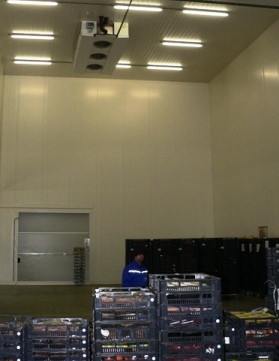A logistics centre with an indirect refrigeration system. In 2007, Goes Handlingcentre situated in De Meern (Holland) expanded its air conditioned warehouses. These warehouses are mainly used for oversees fruit storage. Some of them are equiped with ULO technology allowing Duch fruit to be stored also. When the centre was in the planning and design phase, a system had to be selected that would best meet existing requirements. The limits associated with the use of directly evaporating F gases in the design of this type of plant quickly emerged.
An ammoniac-based plant was also discussed because of its excellent thermodynamic properties. However, this possible design was rejected as well because of increased safety requirements and in particular, because of the risk of contaminating unpackaged products. At the end of the day, indirect refrigeration turned out to be the best solution, given the large amount of power required, the many refrigeration sites and the large distances involved. One of the contractor proposed a plant running with the betain based heat transfer fluid, Thermera, thereby guaranteeing the best possible compatibility with the products to be processed. This was the right solution for Goes.

The main plant specifications, which were sent to the construction firm IVL van Leeuwen BV from Cothen under the overall responsibility of the project leaders Henk Onink and Kees Oostrum, very much highlight the planned capacity of this logistics centre.
The total required cooling capacity comes to 1250kW, which has to supply 65 ‘consumers’ or air coolants with room temperatures of between -1°C and +7°C. A forward temperature (tv) of -6°C and a return flow temperature (tr) of -2°C were selected.
The relatively high temperature levels allowed two effects to be achieved that were very important for the operator, namely: an evaporation temperature of -10°C could be selected for the floating head evaporator, which is close to the working temperature of a comparable directly evaporating plant, in order to keep energy consumption low.
Moreover, as a result of the small temperature range in the air coolants, it was possible to maintain the low level of dehumidification required in certain rooms, which should only be 2.5 liters/ton for stored vegetables. There are many areas of application: ripening rooms with controlled atmospheres, storerooms, processing rooms and rooms for orders or for the packaging of individual deliveries, which all have to be supplied with refrigeration systems from one single plant.

Energy efficiency
Four Bitzer rotary screw compressors from the construction series CSH, with an intake volume of 910m3/h each, provide the actual refrigeration. The refrigerant R134a is used in each of the four separate circuits, mainly because of its better performance figures than R404A/507. A Siemens MVL type electronic expansion valve was used to lower the minimum liquefaction temperature to +10°C.
Combining this with the high evaporation temperature and the small loss of pressure in the refrigerant tubes keeps energy consumption low, an essential consideration given the very high power consumption figures, in particular, in between seasons and in the winter.
The two floating head evaporators supplied by DK, Emsdetten, are integrated into the two buffer storage tanks. The two WILO circulation pumps in the storage tanks ensure a high level of heat exchange from the heat transfer fluid to the evaporator through their whirling action and the resulting high degree of turbulence. The manifolds or suction devices for the heat transfer fluid are nicely fitted to the top end of the evaporator. A Helpman liquefier, which also comes with a small temperature range, rounds off the refrigeration production cycle.
Power consumption for the four Grundfos main pumps chosen comes to just 4 kW, thanks to the small loss of pressure on the heat transfer fluid side of things. Four DN160 main pipes made of PE tubes connect the central machinery room to the operating sites and onto the ‘consumers’, namely a total of 65 Helpman Thor-D and Thor-B air coolants. This also avoids any static problems, since the weight of the DN160 pipes does not cause any significant problems in terms of the load-bearing characteristics of the roof. Operating conditions for the various air coolants are adjusted to meet the requirements of the refrigerated goods, thanks to the different temperature ranges available.
Operating security for the foodstuffs sector thanks to the use of Thermera.
 Thermera -15°C is the heat transfer fluid used. The current net amount comes to 15 tons but once the final construction phase has been completed, the net amount will increase to 22 tons. The heat transfer fluid Thermera has been used at the express request of the client, since Thermera is not actually a chemical as such. It is almost a type of ‘sugary water’ or beet juice, as the raw material, Betaine, is derived from sugar beet. Many of the products stored by Goes are open, unpackaged foodstuffs.
Thermera -15°C is the heat transfer fluid used. The current net amount comes to 15 tons but once the final construction phase has been completed, the net amount will increase to 22 tons. The heat transfer fluid Thermera has been used at the express request of the client, since Thermera is not actually a chemical as such. It is almost a type of ‘sugary water’ or beet juice, as the raw material, Betaine, is derived from sugar beet. Many of the products stored by Goes are open, unpackaged foodstuffs.
Using Thermera means that no risk of unintentional contamination with chemicals can occur at any point in the closely connected system. This was the decisive argument for Goes to choose a natural heat transfer fluid. Even if other heat transfer fluids such as, for example, propylene glycol have been granted an exemption for the foodstuffs sector, a chemical may still unintentionally come into contact with products.
Thermera is on an equal footing with other heat transfer fluids in terms of cold flow properties, viscosity, pressure loss and pump performance, while heat exchange properties are even slightly better.
Author :Vilim Mergl

